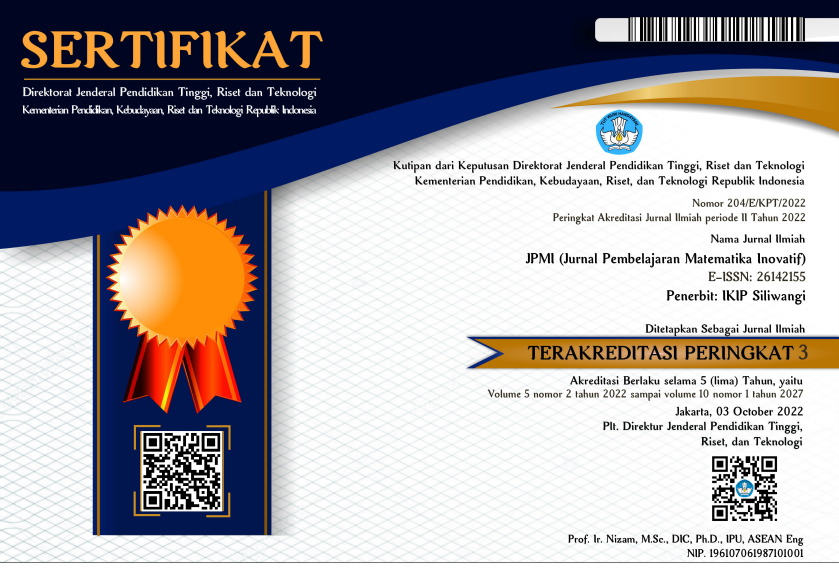Analisis kesulitan matematis mahasiswa berdasarkan teori pemrosesan informasi menggunakan media kahoot!
DOI:
https://doi.org/10.22460/jpmi.v7i5.25006Keywords:
Difficulties of Math, Kahoot, Information TheoryAbstract
This approach focuses on students' thinking procedures. This study aims to describe the obstacles of students in innovative learning using Kahoot! in solving mathematics problems according to Robert Gagne's theory. Information processing theory explains how information is received, processed, and stored in memory, where difficulties can arise at each stage, such as limited short-term memory capacity and problems in encoding information into long-term memory. This research method uses a qualitative descriptive approach, with data collection through observation, interviews, and group discussions. The subjects in this study were all OFF G mathematics students in semester 1 at Malang State University in the 2024/2025 academic year, totaling 30 students. The data obtained in this study were written tests in the form of questions on the material of composition functions and inverse functions and interview guidelines. The research results indicate that: (1) students experience obstacles related to understanding each procedure for solving mathematics problems, concepts, procedures, or principles for working on mathematics problems, and (2) the trigger for students' limitations in learning mathematics is the lack of motivation from students to access information that they do not understand.
References
Anggraeni, S. T., Muryaningsih, S., & Ernawati, A. (2020). Analisis faktor penyebab kesulitan belajar matematika di sekolah dasar. Jurnal Riset Pendidikan Dasar (JRPD), 1(1), 25–37. https://doi.org/10.30595/.v1i1.7929
Aras, G. N., & Ciftci, B. (2021). Comparison of the effect of reinforcement with question-answer and kahoot method on the success and motivation levels of nursing students: A quasi-experimental review. Nurse Education Today, 102(April), 104930. https://doi.org/10.1016/j.nedt.2021.104930
Baddeley, A. (2012). Working memory: Theories, models, and controversies. Annual Review of Psychology, 63, 1–29. https://doi.org/10.1146/annurev-psych-120710-100422
Buyung, & Dwijanto. (2017). Analisis kemampuan literasi matematis melalui pembelajaran inkuiri dengan strategi scaffolding. Unnes Journal of Mathematics Education Research, 6(1), 112–119.
Chaiyo, Y., & Nokham, R. (2017). The effect of kahoot, quizizz and google forms on the student’s perception in the classrooms response system. International Conference on Digital Arts Media and Technology (ICDAMT), 178–182. https://doi.org/10.1016/j.ece.2021.05.005
Gurbin, T. (2015). Enlivening the machinist perspective: Humanising the information processing theory with social and cultural influences. Procedia - Social and Behavioral Sciences, 197(February), 2331–2338. https://doi.org/10.1016/j.sbspro.2015.07.263
Harefa, D. (2022). Student difficulties in learning mathematics. AFORE: Jurnal Pendidikan Matematika, 1(2), 78–86.
Hasriadi, H. (2022). Metode pembelajaran inovatif di era digitalisasi. Jurnal Sinestesia, 12(1), 136–151.
Huijsmans, M. D. E., Kleemans, T., & Kroesbergen, E. H. (2022). The cognitive profiles for different samples of mathematical learning difficulties and their similarity to typical development: evidence from a longitudinal study. Journal of Experimental Child Psychology, 214, 105288. https://doi.org/10.1016/j.jecp.2021.105288
Janah, S. N., Rasiman, R., & Handayanto, A. (2021). Proses berpikir siswa smk dalam memecahkan masalah matematika ditinjau dari gaya kognitif field independent dan field dependent. Imajiner: Jurnal Matematika dan Pendidikan Matematika, 3(2), 150–158. https://doi.org/10.26877/imajiner.v3i2.7487
Kaharuddin, A. (2020). Pembelajaran inovatif & variatif. Pusaka Almaida.
Kauppinen, A., & Choudhary, A. I. (2021). Gamification in entrepreneurship education: a concrete application of kahoot! International Journal of Management Education, 19(3), 100563. https://doi.org/10.1016/j.ijme.2021.100563
Kusaeri, K. (2018). Proses berpikir siswa dalam menyelesaikan masalah matematika berdasarkan teori pemrosesan informasi. Suska Journal of Mathematics Education, 4(2), 125. https://doi.org/10.24014/sjme.v4i2.6098
Martín-Sómer, M., Moreira, J., & Casado, C. (2021). Use of kahoot! to keep students’ motivation during online classes in the lockdown period caused by covid 19. Education for Chemical Engineers, 36(May), 154–159. https://doi.org/10.1016/j.ece.2021.05.005
Miller, G. A. (1956). The magical number seven, plus or minus two: some limits on our capacity for processing information. In Psychological Review (Vol. 63, Nomor 2, hal. 81–97). American Psychological Association. https://doi.org/10.1037/h0043158
Novalita, D., Kamid, & Haryanto. (2022). Analisis kesulitan siswa dalam menyelesaikan soal matematika berdasarkan teori pemrosesan informasi ditinjau dari gaya kognitif. AKSIOMA: Jurnal Matematika dan Pendodikan Matematika, 11(1), 752–761. https://doi.org/10.24127/ajpm.v11i1.4632
Nurhayati, N., Huda, N., & Suratno, S. (2020). Analisis pemecahan masalah berdasarkan teori pemrosesan informasi. Jurnal Ilmiah Dikdaya, 10(2), 136. https://doi.org/10.33087/dikdaya.v10i2.169
Permatasari, K. G. (2021). Problematika pembelajaran matematika di sekolah dasar/ madrasah ibtidaiyah. Jurnal Ilmiah Pedagogy, 17(1), 68–84.
Rafnis, R. (2019). Pemanfaatan platform kahoot sebagai media pembelajaran interaktif. E-Tech: Jurnal Ilmiah Teknologi Pendidikan, 6(2).
Risda, Septriwinti, F. J., & Nasution, F. (2023). Pendekatan pemrosesan informasi. Jurnal Mudabbir, 3(1), 49–59. https://doi.org/10.56832/mudabbir.v3i1.260
Sari, N., & Surya, E. (2017). Analysis effectiveness of using problem posing model in mathematical learning. International Journal of Sciences: Basic and Applied Research (IJSBAR), 33(3), 13–21.
Schoenfeld, A. H. (1985). Mathematical problem solving. Academic Press.
Susanti, I., & Yulaida. (2015). Analisis kesulitan siswa dalam pemahaman materi fungsi komposisi siswa kelas xi semester 2 man pesanggaran tahun pelajaran 2014-2015. Pancaran Pendidikan, 4(4), 99–112.
Wang, A. I. (2015). The Wear out effect of a game-based student response system. Computers & Education, 82, 217–227. https://doi.org/10.1016/j.compedu.2014.11.004
Widya, A. (2020). Model pembelajaran flipped classroom sebagai pembelajaran inovatif abad 21. Jurnal Pendidikan Dasar, 5(1), 49–55.
Wirani, Y., Nabarian, T., & Romadhon, M. S. (2021). Evaluation of continued use on kahoot! as a gamification-based learning platform from the perspective of indonesia students. Procedia Computer Science, 197(2021), 545–556. https://doi.org/10.1016/j.procs.2021.12.172
Yulianti, E. N., Rahmawati, N. D., & Purwosetiyono, F. D. (2021). Analisis kesulitan siswa dalam mengerjakan soal matematika pada materi fungsi komposisi dan fungsi invers ditinjau dari motivasi belajar. Prosiding Seminar Nasional Matematika dan Pendidikan Matematika, 6, 37–41.
Downloads
Published
Issue
Section
License

This work is licensed under a Creative Commons Attribution-ShareAlike 4.0 International License.
The author is responsible for acquiring the permission(s) to reproduce any copyrighted figures, tables, data, or text that are being used in the submitted paper. Authors should note that text quotations of more than 250 words from a published or copyrighted work will require grant of permission from the original publisher to reprint. The written permission letter(s) must be submitted together with the manuscript.
















